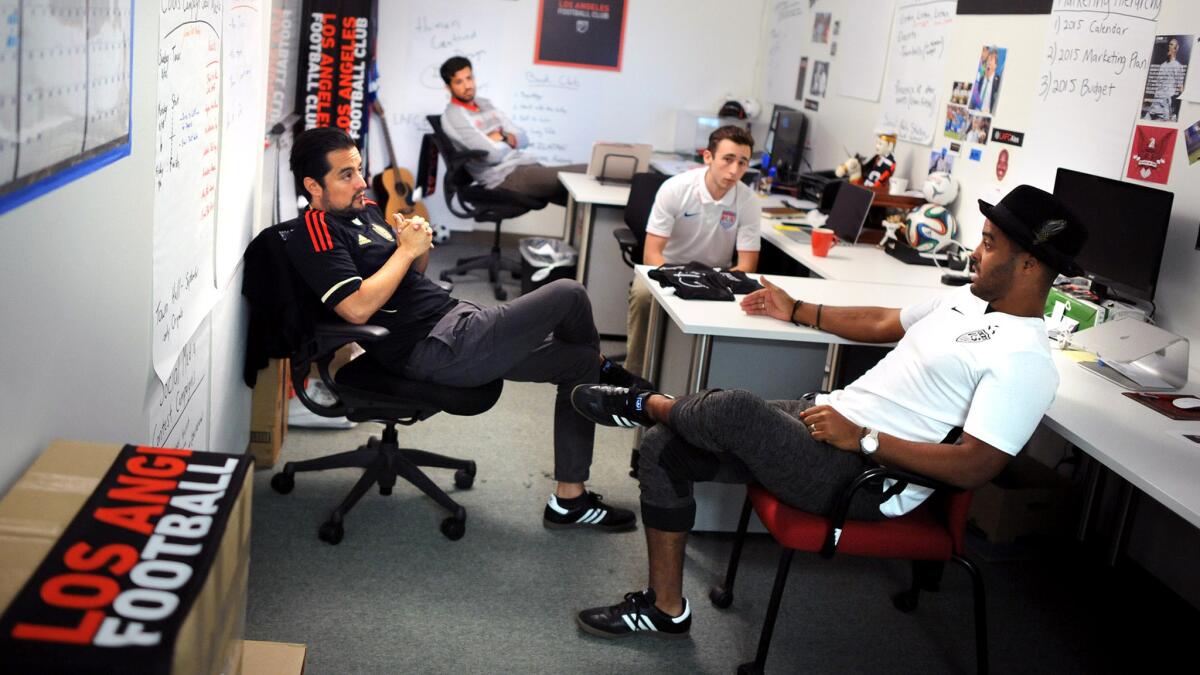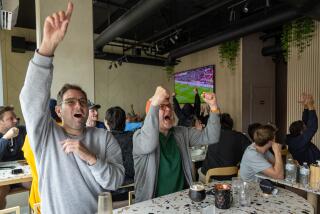Marketing to millennials, Los Angeles Football Club looking to stand apart

LAFC marketing director Rich Orosco, left, talks with his co-workers in the “war room” where planning takes place for the new professional soccer team that is coming to Los Angeles.
In a narrow, windowless room hidden on the third floor of a mid-Wilshire office building, Rich Orosco is making history.
In a marketplace already saturated with professional sports franchises, Orosco is helping create another. Yet 11 months into that process, his team has no stadium, no coaches and no players.
It will announce Tuesday that it does have a name: the Los Angeles Football Club. And while that’s a start, it leaves much to be done before LAFC plays its first Major League Soccer game in 2018.
The go-slow approach is necessary, Orosco says, because LAFC is building more than just a new team. It’s trying to build a new experience as well.
“Our opportunity in L.A. is how do we tell the story differently,” says Orosco, who may be the only head of marketing for culture and community in professional sports history. “We’re going to be big into music, art and fashion. The design aesthetic.
“We’re going to be a great outlet for creativity. It’s one of our club pillars.”
The most important of those principles — nine bullet points organized into three categories — are taped above each of the computers in the cramped work space that Orosco shares with four of LAFC’s 14 employees. Countless other directives, ideas and philosophies are scrawled in black felt-tip pen on huge sheets of butcher paper that line the walls and crowd the desks of what is called the “War Room.”
With the exception of Orosco, who calls himself “a young 42,” none of the five is older than 31. And most came to LAFC last spring from diverse backgrounds that had little to do with sports.
Orosco is married to actress Julie Benz (“Defiance”, “Dexter”) and spent most of his life in television, helping develop the “Entertainment Tonight” spinoff “The Insider” for Paramount before moving to Warner Bros., where, as vice-president of marketing, he helped launch “TMZ on TV” and “Two and a Half Men,” among other projects.
Marcus McDougald, 31, LAFC’s creative director, last worked for YouTube. Patrick Aviles, 29, who heads up the team’s supporter relations, came over from Apple.
No one in the office wears a tie to work. And when they speak, the conversation can be heavy in jargon undecipherable to most people over the age of 40. But it’s a language readily understood by LAFC’s target audience: millennials, a term used to describe the generation that was born between the early 1980s and the early 2000s.
The coveted demographic is more likely to get its information from a mobile device than a traditional source and to consume entertainment, including sports, online and on demand.
Understanding how and when to speak with that audience guides much of what LAFC does these days.
“They don’t want to be talked at,” Orosco says of millennials who, studies show, are 16% more interested in soccer than any other U.S. demographic. “So from Day 1 that’s all we’re doing. We’re opening up a dialogue with this exact fan base: ‘Let’s talk about this.’
“If we weren’t doing that, we’d have a hard time. We want to engage and have a conversation. That’s key.”
That conversation is taking place largely on social media, where millennials live. It’s already helped the club decide on its name and it will influence its choice of colors — red and a variant of gold appear to be the early favorites — and the design of its crest as well.
“They’re very inclusive,” says Angel Mendoza of the Black Army 1850, a soccer support group previously aligned with Chivas USA. The Black Army was abandoned last year when MLS bought the team, disbanded it and sold the franchise rights to a group of 22 millionaires headed by entrepreneur Henry Nguyen, Mandalay Entertainment CEO Peter Guber and former NBA executive and ESPN analyst Tom Penn.
“When Henry and Tom announced the club … they were talking about a club for the people,” says Mendoza, 32. “They wanted a club that represents the city of Los Angeles.”
But that’s not the only reason that Mendoza and his wife Cindy are saving their allegiances for a team that doesn’t yet exist. The fact they’re able to influence a franchise being built from scratch, an experience they’ll someday be able to share with their two young daughters, also is part of the draw.
“This is something where they’re going to say, ‘Hey, you know what? I was 5 and 4 when this started.’ How many people can say that? My parents had a hand in this.”
It’s an opportunity that may not be repeated for a long time in the crowded Southern California sports marketplace. The market already has two NBA teams, two NHL teams, two big league baseball teams and the Galaxy, the most successful franchise in MLS history.
There’s an Arena Football team, a WNBA team, an NBA D-League team and a roller derby squad. Even the Independent Women’s Football League has a team in L.A. County.
And if the NFL comes, it’s almost certain to move an existing franchise here rather than form a new one. So the challenge to get what may be the city’s last expansion launch done right is one that LAFC is taking seriously.
“You want to give your fans and supporters a real sense of ownership that they are part of this movement,” says Nguyen, a Harvard graduate who founded a professional basketball team and aided in a number of technology start-ups in his native Vietnam. “When you are a brand new club like ours, we really don’t have any on-field product to sell. But we do have a vision and a goal.
“In many ways I liken it to a political campaign. We have to sell our vision and really get people behind it.”
Part of that identity will be the team’s new $250-million stadium complex, which will be built next to the Coliseum on land currently occupied by the Sports Arena. Even that’s just a concept and a set of blueprints at this point, but fans are buying into it since LAFC has already accepted thousands of deposits for seat licenses.
“We haven’t put one shovel into the ground or laid one brick,” Nguyen says, “but we’re excited about the location. What’s beautiful about this opportunity: It’s a clean slate to really build a modern sports organization.”
Because for all the listening and community building LAFC has done, for all the care it has taken to get its name and its colors and its crest just right, the stadium may do more than anything else to define the club’s character and attitude leading up to its first game.
“I have been personally surprised at just how all-consuming the creation process is when it comes to the stadium or it comes to doing the brand just right,” Penn says. “So yeah, I’d love to be cheering wins and losses or high-fiving at games.
“But if we’re going to be special, all this formative work that we’re doing is critically important.”







